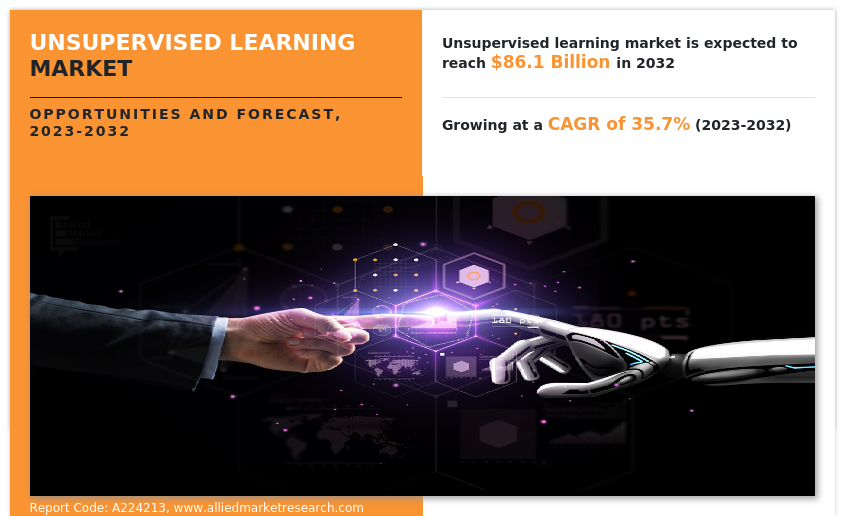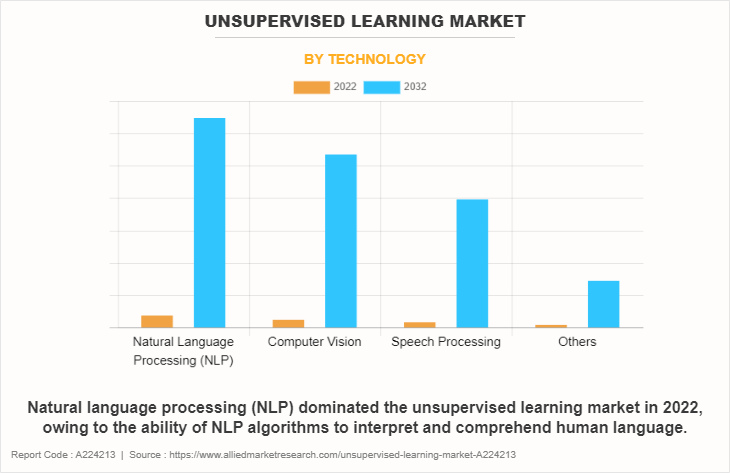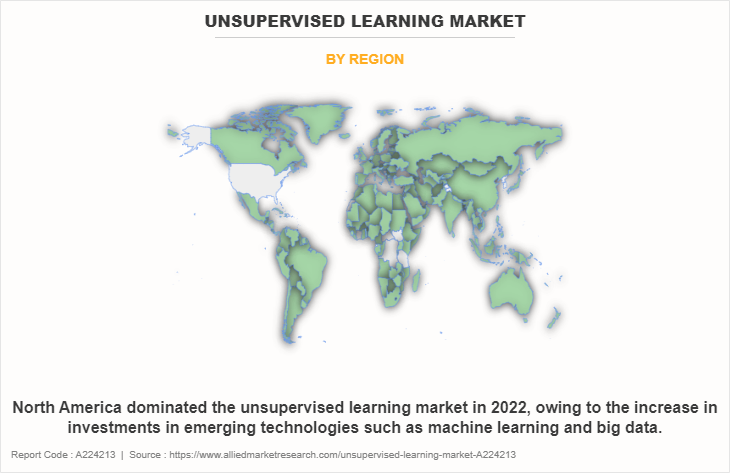Unsupervised Learning Market Overview
The global unsupervised learning market was valued at USD 4.2 billion in 2022, and is projected to reach USD 86.1 billion by 2032, growing at a CAGR of 35.7% from 2023 to 2032.
Growth in availability of huge and diverse datasets and advancements in artificial intelligence and machine learning techniques primarily drive the growth of the unsupervised learning market. However, lack of interpretability and explain ability hamper the market growth to some extent. Moreover, rise in demand for anomaly detection and cybersecurity is expected to provide lucrative opportunities for unsupervised learning market forecast.

The industry and ecosystem that support the creation, implementation, and use of unsupervised learning algorithms and solutions are collectively referred to as the unsupervised learning market. In the ML subfield known as unsupervised learning, models are trained on unlabeled data without direct human supervision or labels. Unsupervised learning techniques are used by corporations and organizations to gather insights from huge and complicated datasets. Anomaly detection, dimensionality reduction, clustering related data points, and data visualization are a few examples of uses for unsupervised learning techniques. Data scientists, machine learning engineers, software suppliers, technology providers, researchers, and researchers who create and enhance unsupervised learning tools and algorithms form the unsupervised learning market.
Moreover, the market consists of sectors including banking, healthcare, retail, manufacturing, and telecommunications that significantly rely on unsupervised learning. The growth in availability of large data, improvements in computer power, and the rise in demand for automated data analysis and insights are some of the key factors propelling the unsupervised learning industry. The usage of unsupervised learning solutions is anticipated to keep growing as businesses seek to leverage data for value and a competitive edge.
Segment Overview
The unsupervised learning market is segmented on the basis of technology, deployment mode, enterprise size, end user and region. On the basis of technology, it is categorized into natural language processing (NLP), speech processing, computer vision, and others. On the basis of deployment mode, it is bifurcated into on-premise and cloud. On the basis of enterprise size, it is bifurcated into large enterprise and small and medium-sized enterprise (SMEs). On the basis of end user, it is fragmented into BFSI, IT and telecom, healthcare, retail and e-commerce, government, automotive and transportation and others. On the basis of region, it is analyzed across North America, Europe, Asia-Pacific, and LAMEA.

On the basis of technology, natural language processing segment dominated the unsupervised learning market share in 2022 and is expected to maintain its dominance in the upcoming years, owing to offers companies to learn more about consumer preferences, market trends, and emerging patterns, resulting in more informed strategic planning and decision-making propels the market growth significantly. However, the speech processing segment is expected to witness the highest growth, owing to improve service delivery, personalize experiences, and improve decision-making by utilizing unsupervised learning models to acquire a deeper understanding of customer sentiment, preferences, and behaviour.

Region-wise, North America dominated the unsupervised learning market size in 2022, owing to the increase in investments in emerging technologies such as machine learning and big data. This comprises both organized and unstructured data, such as text, photos, and videos, as well as databases and spreadsheets. As a result, without the requirement for significant labeling, unsupervised learning approaches are well suited in North America to obtaining useful insights from such data. However, Asia-Pacific is expected to be the fastest growing in 2022, owing to major investment proceeding for the development of IT infrastructure with an installation of smart technologies such as AI and ML. In addition, in Asia-Pacific unsupervised learning has emerged as the most effective technique for discovering patterns in data.
Key Market Players
The global unsupervised learning industry is dominated by key players such as Microsoft Corporation, SAP SE, International Business Machines Corporation, Amazon.Com, Inc., Google LLC, Cloud Software Group, Inc., H2o.Ai, Rapidminer, Databricks, and Oracle Corporation. These players have adopted various strategies to increase their market penetration and strengthen their position in the unsupervised learning industry.
Top Impacting Factors
Growth in Availability of Huge and Diverse Datasets
The growth in accessibility of large and diverse datasets is one of the key factors that drive the unsupervised learning market. Huge volumes of data are produced daily as a result of the spread of digital technology and the internet. This information is gathered from a variety of sources, including social media, sensors, hardware, and internet platforms. The availability of such huge datasets offers businesses a wealth of resources to gain insightful information and make wise decisions. The analysis and pattern-finding of these datasets is particularly well-suited to unsupervised learning methods. Unsupervised learning algorithms use unlabeled data, in contrast to supervised learning, which needs labelled examples for training. As a result, businesses utilize their current datasets without investing in time-consuming and expensive labelling procedures.
There is an increase in demand for unsupervised learning solutions across numerous industries as big data becomes more widely available. Organizations employ unsupervised learning algorithms in the financial sector, for instance, to examine financial transactions and spot trends that can point to fraudulent activity. In the healthcare sector, unsupervised learning is frequently utilized to analyze patient data and find patterns or anomalies that could help with disease diagnosis or the design of treatment schedules. Moreover, by analyzing consumer behavior and preferences, unsupervised learning can be deployed in retail to create personalized advertising strategies. The effectiveness of operations, customer experiences, and decision-making are all significantly impacted by the capacity to extract insightful knowledge from massive and heterogeneous information.
Advancements in Artificial Intelligence and Machine Learning Techniques
Another significant factor that the unsupervised learning industry is the development of AI and ML methods. Significant advances in AI and ML over the years have prompted the creation of more complex algorithms and models. One significant achievement is the creation of deep learning algorithms, a subset of machine learning algorithms that are motivated by the composition and operation of the human brain. Deep learning algorithms, such as deep neural networks, have the capacity to automatically learn hierarchical data representations, enabling them to draw complex correlations and patterns from huge and varied datasets. This makes them especially suitable for tasks requiring unsupervised learning. The expansion of computing power and storage capacity is another development.
Businesses are now able to process and analyze enormous amounts of data quickly with the development of technologies like cloud computing and distributed computing. Unsupervised learning models can now be trained and used more effectively as a result. In addition, tools for feature engineering and data pretreatment have advanced. Before sending raw data into an unsupervised learning algorithm, data preprocessing entails cleaning, converting, and normalizing the data. Feature engineering is the process of choosing or producing pertinent features from data that can enhance the performance of algorithms. These methods aid in raising the caliber and usefulness of the data utilized in unsupervised learning, producing more precise and significant insights.
Key Benefits for Stakeholders
This report provides a quantitative analysis of the market segments, current trends, estimations, and dynamics of the unsupervised learning market analysis from 2022 to 2032 to identify the prevailing unsupervised learning market growth.
The market research is offered along with information related to key drivers, restraints, and opportunities.
Porter's five forces analysis highlights the potency of buyers and suppliers to enable stakeholders make profit-oriented business decisions and strengthen their supplier-buyer network.
In-depth analysis of the unsupervised learning market segmentation assists to determine the prevailing market opportunities.
Major countries in each region are mapped according to their revenue contribution to the global market.
Market player positioning facilitates benchmarking and provides a clear understanding of the present position of the market players.
The report includes the analysis of the regional as well as global unsupervised learning market trends, key players, market segments, application areas, and market growth strategies.
Unsupervised Learning Market Report Highlights
| Aspects | Details |
| Market Size By 2032 | USD 86.1 billion |
| Growth Rate | CAGR of 35.7% |
| Forecast period | 2022 - 2032 |
| Report Pages | 357 |
| By Technology |
|
| By Deployment Mode |
|
| By Enterprise Size |
|
| By End User |
|
| By Region |
|
| Key Market Players | Cloud Software Group, Inc., SAP SE, Google LLC, Oracle Corporation, Microsoft Corporation, Amazon.com, Inc., International Business Machines Corporation, RapidMiner, H2O.ai, Databricks |
Analyst Review
The unsupervised learning market has expanded significantly as businesses in a wide range of sectors realize the value of getting insights from their unlabeled data. The branch of machine learning known as unsupervised learning refers to the process when algorithms are taught on data without direct human supervision or labelling. Large and complicated datasets can now be handled by advanced analytics methods due to the exponential expansion of the big data industry.? Unsupervised learning algorithms excel in the area and help businesses make data-driven decisions by identifying hidden patterns and connections in the data. Massive volumes of data can now be processed and analyzed effectively owing to advances in computing power.? This has created new possibilities for unsupervised learning due to the faster execution of complex algorithms, which permits real-time analysis and insights. In addition, there is a significant rise in demand for automated data analysis and insights. Businesses have sought methods to get maximum benefit of their data without manual labelling or human interaction. Unsupervised learning offers a solution to this problem, empowering organizations to make intelligent decisions and optimize their processes by automatically detecting anomalies, clusters, and patterns within the data. Several industries, including finance, healthcare, retail, manufacturing, and telecommunications, are adopting this approach rapidly. Unsupervised learning is being used in several industries to gain further insight into consumers, identify fraud, streamline supply chains, boost patient outcomes, and increase overall operational effectiveness.
The global unsupervised learning market was valued at $ 4,163.92 million in 2022 and is projected to reach $ 86,084.89 million by 2032, registering a CAGR of 35.7% from 2023 to 2032.
The global unsupervised learning industry is dominated by key players such as Microsoft Corporation, Sap Se, International Business Machines Corporation, Amazon.Com, Inc., Google LLC, Cloud Software Group, Inc., H2o.Ai, Rapidminer, Databricks, and Oracle Corporation. These players have adopted various strategies to increase their market penetration and strengthen their position in the unsupervised learning industry.
North America is the largest regional market for Unsupervised Learning
Rise in demand for anomaly detection and cybersecurity is the leading application of Unsupervised Learning Market
Growth in availability of huge and diverse datasets and advancements in artificial intelligence and machine learning techniques are the upcoming trends of Unsupervised Learning Market in the world
Loading Table Of Content...
Loading Research Methodology...



